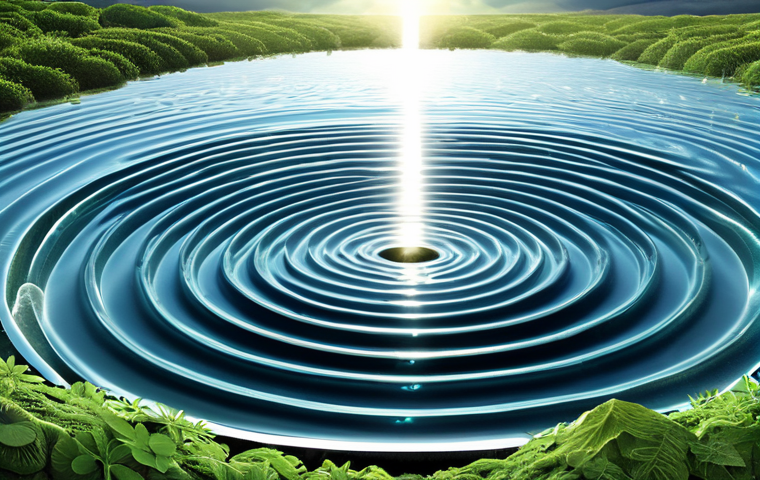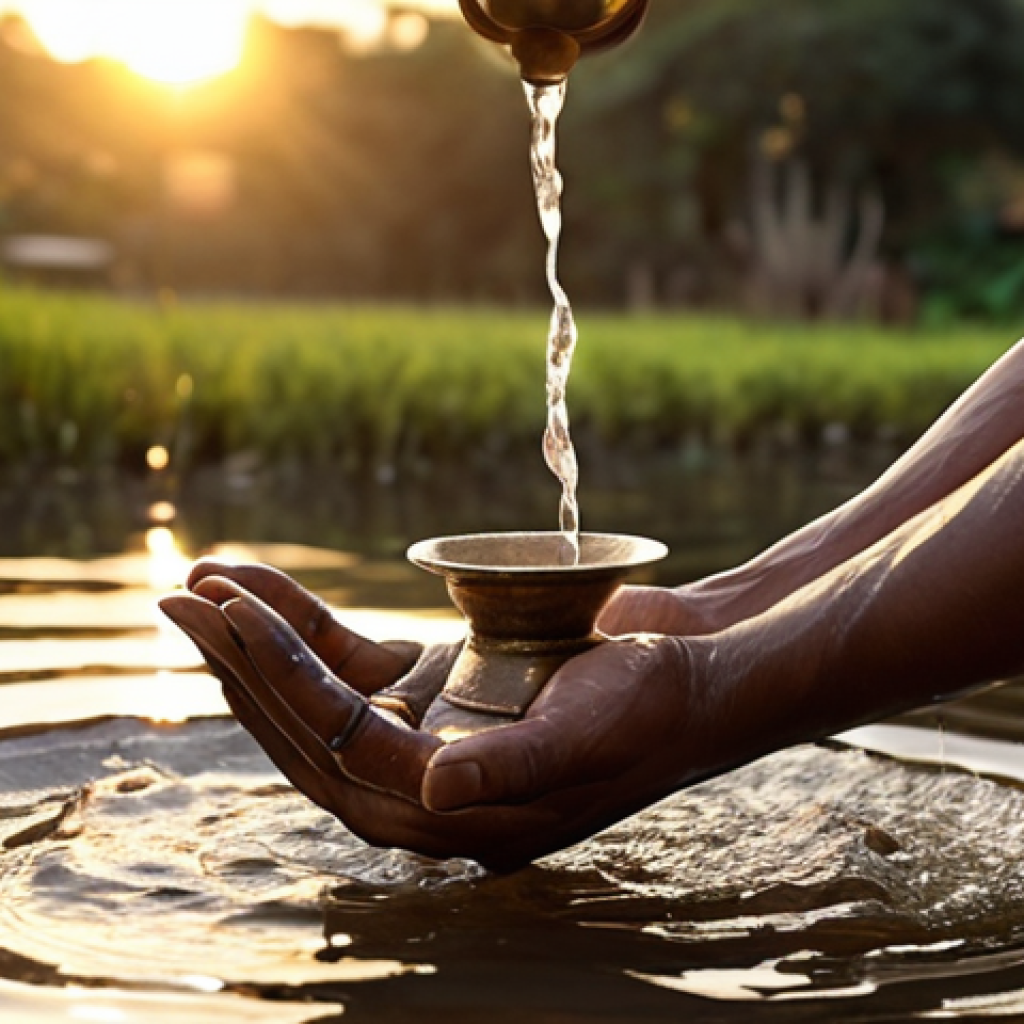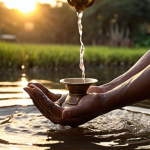In our relentlessly fast-paced world, where digital noise often drowns out the whispers of our inner selves, there’s a profound ancient practice quietly gaining renewed attention: the Hindu ritual of water oblation.
It’s more than just a ceremonial pouring; it’s a deeply resonant act of gratitude, purification, and connection to the divine, mirroring the growing global thirst for authentic spiritual grounding.
Having personally witnessed its serene beauty, I’ve found myself drawn to its profound simplicity, a stark contrast to the complex solutions often sought for modern anxieties.
This timeless act of offering water, or *Jal Arpan*, speaks to our innate human need for reverence, reminding us that true peace often lies in the most elemental gestures.
As mindfulness and holistic wellness continue to dominate conversations about mental health, understanding such ancient rites provides a powerful bridge between tradition and contemporary well-being, suggesting that the future of personal fulfillment might just involve looking back to foundational practices like these.
Let’s find out precisely what makes this ritual so enduring and relevant today.
In our relentlessly fast-paced world, where digital noise often drowns out the whispers of our inner selves, there’s a profound ancient practice quietly gaining renewed attention: the Hindu ritual of water oblation.
It’s more than just a ceremonial pouring; it’s a deeply resonant act of gratitude, purification, and connection to the divine, mirroring the growing global thirst for authentic spiritual grounding.
Having personally witnessed its serene beauty, I’ve found myself drawn to its profound simplicity, a stark contrast to the complex solutions often sought for modern anxieties.
This timeless act of offering water, or *Jal Arpan*, speaks to our innate human need for reverence, reminding us that true peace often lies in the most elemental gestures.
As mindfulness and holistic wellness continue to dominate conversations about mental health, understanding such ancient rites provides a powerful bridge between tradition and contemporary well-being, suggesting that the future of personal fulfillment might just involve looking back to foundational practices like these.
Let’s find out precisely what makes this ritual so enduring and relevant today.
Unlocking the Power of Elemental Offerings

There’s an undeniable allure to rituals that connect us with the raw, untamed forces of nature, and the act of offering water truly embodies this. I remember the first time I saw *Jal Arpan* being performed; the simple grace, the deliberate movements, the profound quietude it evoked. It wasn’t just about the water; it was about the intention, the focus, the conscious engagement with an element so fundamental to life itself. We often forget the sacredness of water in our everyday lives, treating it as a mere commodity. Yet, in countless cultures, it has always been revered as a symbol of purity, life, and transformation. This practice re-establishes that lost reverence, reminding us that true connection often begins with the simplest, most accessible resources right before our eyes. It’s a moment of deliberate pause, a conscious decision to acknowledge something larger than ourselves, using the very substance that flows through our veins and sustains our planet.
Embracing Water’s Transformative Symbolism
Water, in its fluid, ever-changing nature, holds profound spiritual significance across nearly every civilization known to humanity. What I’ve learned from witnessing and studying *Jal Arpan* is how it harnesses these universal symbols to create a deeply personal and collective experience.
- Purity and Cleansing: Water inherently symbolizes purification. The act of offering it is not just about physical cleansing, but a deep spiritual one, washing away negative thoughts and intentions, leaving space for clarity and renewed purpose.
- Life and Sustenance: Without water, life as we know it simply cannot exist. Offering water is an acknowledgment of this fundamental truth, a gesture of gratitude for the life-sustaining force it represents, and a prayer for continued abundance.
- Flow and Change: Water is never stagnant; it flows, adapts, and transforms. This mirrors life’s impermanence and constant evolution. The ritual encourages acceptance of change, letting go of what no longer serves us, and embracing the natural currents of existence.
This multifaceted symbolism makes the ritual incredibly rich and accessible, resonating with anyone who seeks a deeper connection to life’s fundamental truths.
Cultivating Mindful Presence Through Simple Acts
In our hyper-connected, distracted world, the simple act of offering water becomes a powerful lesson in mindfulness. It’s not about grand gestures or complex meditations; it’s about being fully present in a single, focused action. As someone who constantly battles the urge to multitask, I’ve found immense value in practices that demand my complete attention.
- Sensory Engagement: The cool touch of water, the gentle sound of its pour, the visual flow—all these engage our senses, pulling us away from mental chatter and into the present moment. It’s a grounding experience that brings awareness to the body and its surroundings.
- Intentionality and Focus: Each drop offered is imbued with intention, whether it’s gratitude, an offering, or a prayer. This focused intention sharpens the mind and directs energy, creating a powerful spiritual anchor in a fleeting world.
- Breathing and Rhythm: The ritual often involves a calm, measured pace, aligning with the breath. This natural rhythm induces a meditative state, reducing stress and fostering a sense of inner calm that can last long after the ritual concludes.
It’s a beautiful reminder that profound spiritual experiences don’t always require elaborate setups; sometimes, all it takes is a conscious engagement with the ordinary.
The Echo of Gratitude: A Universal Language
At its heart, the water oblation ritual is a profound expression of gratitude. It’s a deeply personal act, yet it resonates with a universal human need to acknowledge and appreciate the blessings in our lives. In an era where consumerism often drives us to constantly seek more, taking a moment to simply give back, to express thanks for the elemental forces that sustain us, feels incredibly liberating. I’ve personally felt a profound shift in my perspective after engaging with practices centered on gratitude; it changes how you view everything, from the smallest comforts to the grandest miracles. This ritual, with its focus on giving something back to the source, reinforces that essential connection, reminding us that we are part of a larger ecosystem of giving and receiving. It’s a powerful antidote to feelings of scarcity and inadequacy, replacing them with a sense of abundance and interconnectedness.
Connecting to the Divine Within and Without
One of the most striking aspects of this practice is its ability to bridge the gap between the individual and the divine. It’s not just about offering to an external deity, but also about recognizing the sacredness within oneself and in all living things.
- Personal Devotion: The ritual allows for a deeply personal expression of devotion, tailored to one’s own beliefs and intentions. It’s a dialogue with the divine that transcends formal doctrines, making spirituality accessible and intimate.
- Universal Consciousness: By offering water to the sun, rivers, or specific deities, participants acknowledge a universal energy or consciousness that pervades all existence. This broadens one’s perspective, fostering a sense of unity with the cosmos.
- Inner Reflection: The quiet moments of offering naturally lead to introspection. It’s a chance to reflect on one’s actions, intentions, and place in the world, fostering spiritual growth and self-awareness that is crucial for personal development.
This duality of external offering and internal reflection is what makes the practice so holistic and deeply satisfying, touching both the tangible and intangible aspects of our spiritual lives.
Benefits of Embracing Gratitude Rituals
The act of regularly expressing gratitude, particularly through a ritual like water oblation, yields a cascade of positive effects that extend far beyond the spiritual realm. I’ve personally experienced these benefits, and the scientific literature increasingly supports them.
- Enhanced Well-being: Cultivating gratitude has been linked to increased feelings of happiness, optimism, and overall life satisfaction. The ritual provides a structured way to practice this vital emotion regularly.
- Reduced Stress and Anxiety: Focusing on what we are thankful for shifts our perspective away from worries and fears. The calming nature of the water offering can lower cortisol levels, promoting relaxation and mental peace.
- Stronger Relationships: Gratitude helps us appreciate others and the world around us. This fosters empathy, compassion, and stronger bonds, not just with other people but with the environment itself.
- Improved Physical Health: Studies suggest that grateful individuals often report better sleep, fewer aches and pains, and a stronger immune system, highlighting the profound mind-body connection.
It’s truly a testament to how ancient wisdom can offer powerful, practical solutions to modern challenges, simply by guiding us back to fundamental human virtues.
Daily Rituals for a Grounded Existence
While the Hindu water oblation is rooted in specific spiritual traditions, its core principles of mindfulness, gratitude, and connection are universally applicable. What I find truly compelling is how easily such a practice can be adapted and integrated into a contemporary, often chaotic, daily routine. You don’t need elaborate ceremonies or special equipment; the essence lies in the intention and consistency. I’ve often thought about how many of us yearn for more meaning in our daily lives, something beyond the endless scroll and the relentless to-do lists. Simple, intentional rituals, like a daily water offering, can provide that much-needed anchor. They transform mundane moments into sacred ones, imbuing ordinary actions with extraordinary significance. This isn’t about becoming someone else; it’s about reclaiming parts of ourselves that have been lost in the digital deluge – our capacity for reverence, our connection to the simple, life-giving elements, and our ability to find profound peace in quiet moments.
Simplifying the Practice for Modern Living
For those of us navigating the demands of contemporary life, incorporating a profound ritual like *Jal Arpan* might seem daunting at first. However, its beauty lies in its adaptability.
- Morning Intention Setting: Begin your day by pouring a small glass of water, holding it with both hands, and silently expressing gratitude for the day ahead, for your health, or for a specific blessing. Pour it onto a plant or into a natural body of water if accessible.
- Mindful Hydration: Before drinking water throughout the day, take a moment to acknowledge its life-giving properties. This transforms a basic need into an act of reverence and mindfulness.
- Evening Release: Before bed, use water as a symbol for releasing the day’s stresses. A quick hand-wash with conscious intention can become a ritual of purification and letting go, preparing you for restful sleep.
These small, consistent acts build a powerful habit of presence and gratitude, weaving spirituality seamlessly into your daily rhythm.
The Transformative Power of Consistency
Like any habit, the true power of daily rituals emerges from consistency. It’s not the grandness of a single act, but the cumulative effect of repeated, intentional gestures that creates lasting change. I’ve personally seen how a small, daily commitment can snowball into significant shifts in perspective and well-being.
- Building Spiritual Muscle: Just as physical exercise strengthens the body, consistent spiritual practices strengthen our inner resolve, emotional resilience, and connection to something larger than ourselves.
- Creating Sacred Space: Regular engagement with a ritual transforms the mundane surroundings into a sacred space, fostering an atmosphere of calm and reverence in your home or personal environment.
- Anchoring Against Chaos: In moments of stress or uncertainty, having a go-to ritual provides a familiar anchor, a comforting routine that helps to recenter and regain perspective, reminding you of underlying stability.
The commitment to these small acts is an investment in your own peace of mind, a testament to the belief that the profound can indeed be found in the profoundly simple.
Nurturing Connection: Why Water Resonates Globally
It’s fascinating to consider why the act of offering water, in various forms, has persisted across such diverse cultures and throughout millennia. While the Hindu ritual has specific roots, the underlying reverence for water as a sacred element is remarkably universal. From ancient Celtic wells to Native American rain dances, water has always been seen as a source of life, healing, and spiritual communion. What I’ve come to understand is that our innate human connection to water is deeply primal; our bodies are mostly water, our planet is covered by it, and life itself began in its depths. This fundamental link makes water an incredibly potent conduit for spiritual expression, transcending language and cultural barriers. When we engage with water mindfully, whether in a ritual or simply by appreciating a glass of it, we tap into a universal energy, a shared understanding of its vital importance, and a timeless echo of human devotion. This shared reverence, in a world often divided, offers a beautiful point of commonality and understanding.
The Universal Language of Sacred Liquids
Across the globe, civilizations have recognized water’s unique properties, elevating it beyond a mere physical substance to a potent spiritual medium.
- Baptism and Rebirth: In Christianity, water symbolizes cleansing and new life, marking a spiritual rebirth.
- Ablution in Islam: Wudu, the ritual washing before prayer, emphasizes purity and preparation for divine communion.
- Japanese Water Purification: Misogi, a Shinto practice, involves standing under a waterfall to purify the body and mind.
- Indigenous Rain Dances: Many native cultures perform dances and offerings to invite life-giving rain, demonstrating a deep respect for water’s power over sustenance.
These examples highlight a collective human recognition of water’s power to cleanse, sustain, and connect us to the sacred. The Hindu water oblation draws from this same wellspring of universal understanding, making it accessible on a deeper, intuitive level for anyone, regardless of their background.
| Aspect of Jal Arpan | Spiritual Significance | Modern Life Benefit |
|---|---|---|
| Offering Water | Gratitude, humility, acknowledging divinity. | Fosters appreciation, reduces entitlement. |
| Element of Water | Purity, flow, life, healing. | Promotes mindfulness, reduces stress, symbolizes letting go. |
| Intentionality | Focusing energy, setting prayers. | Enhances mental clarity, purpose, positive self-talk. |
| Consistency | Building spiritual discipline. | Creates healthy routines, improves emotional resilience. |
| Connection to Sun/Deity | Acknowledging cosmic energies, higher power. | Broadens perspective, reduces feelings of isolation. |
Bridging Ancient Wisdom and Contemporary Well-being
It might seem counterintuitive to look to ancient rituals for solutions to modern problems, but as I’ve delved deeper, I’ve found that the profound wisdom embedded in these practices offers surprisingly relevant benefits for our contemporary well-being. The water oblation is a prime example of this convergence.
- Mental Clarity: The focused nature of the ritual helps quiet the incessant mental chatter that often accompanies modern life, offering moments of profound stillness and clarity.
- Emotional Regulation: The act of offering and letting go can be deeply therapeutic, helping to release emotional burdens and cultivate a sense of inner peace. It’s a natural way to process feelings without needing extensive therapy.
- Holistic Health: By integrating the mind, body, and spirit, the practice promotes a holistic approach to health. It reminds us that our well-being isn’t just about physical health or mental sharpness, but also about spiritual alignment.
- Sense of Belonging: Engaging in a timeless practice connects us to a lineage of human experience, fostering a sense of belonging to something larger than ourselves, reducing feelings of isolation in an increasingly atomized world.
This ritual serves as a gentle yet powerful reminder that the path to a fulfilling life often lies in rediscovering and re-engaging with fundamental truths and simple, heartfelt actions.
Embracing the Spiritual Current in Everyday Life
Ultimately, what I’ve taken away from exploring the ancient practice of water oblation isn’t just an understanding of a ritual, but a profound appreciation for how spirituality can be woven into the very fabric of our everyday lives. It teaches us that sacredness isn’t confined to temples or designated meditation cushions; it can be found in the mundane act of pouring water, in the simple act of breathing, in the quiet appreciation of a sunrise. This perspective has truly transformed my own approach to well-being, shifting from a constant pursuit of external solutions to a cultivation of inner peace through intentional living. It’s about recognizing that we are not separate from the world around us, but intimately connected to its elemental forces and its divine essence. The beauty of this realization is that it empowers us; it tells us that the tools for a more grounded, grateful, and peaceful existence are already within our reach, often in the simplest of forms.
Integrating Reverence Beyond the Ritual
The lessons learned from a formal water oblation ritual can easily transcend the specific act, enriching our entire daily experience. It’s about cultivating a mindset of reverence and intention in all we do.
- Mindful Hydration: Every sip of water can become a small act of gratitude, acknowledging its life-sustaining properties.
- Connecting with Nature: Taking a moment to appreciate rainfall, the flow of a river, or even watering a plant can become a mini-ritual of connection.
- Everyday Offerings: Extend the concept of “offering” to your actions—offering kindness, offering your best effort, offering a listening ear. These become small acts of conscious contribution.
- Embracing Flow: Just as water flows and adapts, we can practice embracing the flow of life, navigating changes with greater ease and resilience, rather than resisting them.
By doing so, we transform ordinary moments into opportunities for spiritual growth and connection, making our entire day a living prayer.
The Ripple Effect: From Personal Practice to Planetary Well-being
The beauty of a deeply personal spiritual practice like water oblation is its potential for a far-reaching ripple effect. What begins as an individual act of reverence can inspire a greater appreciation for our planet’s most vital resource, fostering a sense of environmental stewardship.
- Environmental Consciousness: When we treat water as sacred, we naturally become more mindful of its conservation and purity. This reverence translates into practical actions that benefit our planet.
- Community Connection: Sharing insights from such a practice can open dialogues about universal values like gratitude, sustainability, and interconnectedness, building bridges within communities.
- Inspiring Others: A personal commitment to a mindful, grateful existence often inspires those around us. By embodying these values, we become catalysts for positive change, showing others that peace is attainable.
It’s a powerful testament to how small, intentional acts, rooted in ancient wisdom, can contribute to a larger movement of awareness and care for both ourselves and the world we inhabit. This timeless practice, truly, is more relevant now than ever before.
Conclusion
What I’ve truly taken from this exploration of the ancient Hindu water oblation ritual is not just an understanding of its history, but a profound appreciation for how ancient wisdom can directly address our modern anxieties.
In a world constantly pushing us towards more, faster, and louder, the simple, quiet act of offering water reminds us that profound peace often resides in the most elemental gestures.
My own journey with practices like these has underscored the incredible power of intentionality and gratitude, proving that authentic spiritual grounding isn’t out of reach; it’s often right here, flowing in the very water we drink.
It’s a testament to the enduring relevance of practices that connect us to something larger, something truly timeless.
Helpful Resources for Your Journey
If you’re feeling drawn to incorporate similar elements of mindfulness and gratitude into your daily life, here are a few ideas and resources that might spark your journey:
1. Explore Local Wellness Centers: Many communities offer mindfulness workshops, meditation classes, or even discussions on ancient spiritual practices. Look for centers that emphasize holistic well-being rather than strict religious dogma.
2. Reputable Online Learning Platforms: Websites like Coursera, edX, or even specific spiritual non-profits (e.g., The Chopra Center, Himalayan Institute) offer courses on mindfulness, yoga, and Vedic wisdom that can deepen your understanding.
3. Mindful Hydration Practices: Try dedicating a full minute to consciously drinking your first glass of water each morning. Notice its temperature, how it feels, and silently offer gratitude for its life-sustaining properties. It’s a simple shift with big impact.
4. Journaling Your Gratitude: Complement any water-based ritual with a gratitude journal. Regularly noting down things you’re thankful for amplifies the positive effects of practices like *Jal Arpan*, solidifying a mindset of abundance.
5. Respect Cultural Context: While adapting principles is encouraged, always approach ancient practices with respect for their origins. Learn about the traditions, acknowledge their roots, and ensure your adaptation honors the source rather than appropriating it.
Key Takeaways
The ancient Hindu water oblation, or *Jal Arpan*, is far more than a ceremonial act; it’s a profound, accessible pathway to modern well-being. At its core, this ritual teaches us the transformative power of gratitude, the grounding effects of mindful presence, and the deep human need for connection to the elemental forces that sustain us. By integrating such simple, intentional practices into our daily lives, we can cultivate enhanced mental clarity, emotional resilience, and a profound sense of inner peace, proving that some of the most potent solutions for contemporary challenges lie in rediscovering timeless wisdom.
Frequently Asked Questions (FAQ) 📖
Q: So, it’s called ‘Jal
A: rpan’ – but what’s really happening when someone performs this Hindu water oblation? Is it just, well, pouring water? A1: Oh, no, it’s absolutely not just pouring water!
That’s like saying meditation is just sitting still, you know? From the outside, sure, it looks simple: you take some water, maybe offer it to the sun or a deity.
But what I’ve genuinely felt, having actually done it, is that it’s this incredibly potent, deeply personal dialogue. It’s an act of profound gratitude – like you’re literally pouring out your thanks for everything, for the water itself, for life.
It cleanses not just symbolically, but almost like it washes away the clutter in your own mind. It’s a moment of pure, unadulterated presence, where you’re connecting to something so much bigger than yourself.
It hits you right in the gut, honestly, how powerful something so elemental can be.
Q: In our crazy, always-on world, why would an ancient practice like water oblation still matter to someone trying to keep it together?
A: That’s the million-dollar question, isn’t it? And it’s one I’ve grappled with myself, living in this whirlwind. Honestly, it’s precisely because our world is so fast and noisy that practices like Jal Arpan become so vital.
We’re constantly bombarded with digital static, chasing the next big thing, always doing. And then you have this ritual – quiet, simple, just you and the water.
It forces you to slow down. It’s a direct antidote to the mental exhaustion, this constant need to be productive. My own experience is that it slices through the digital din and brings you back to something truly foundational, something that grounds you instantly.
It’s like finding a still, clear pool in the middle of a bustling city. The relief, the calm… it’s palpable.
We’re searching for authentic connection, and sometimes it’s found in these gestures that have stood the test of time, not in another app or a complex self-help book.
Q: Okay, so if I’m not Hindu or deeply spiritual, can I still experience the benefits of this kind of practice, or is it exclusively for specific faiths?
A: Oh, absolutely, 100%! And this is where it gets really interesting, I think. While Jal Arpan originates from Hindu traditions, the essence of what it offers – gratitude, purification, connection – is profoundly universal.
You don’t need to subscribe to a specific dogma to appreciate the profound power of offering thanks, of intentionally releasing what no longer serves you, or feeling a kinship with the elemental forces of nature.
I’ve found that even approaching it as a mindful moment, a personal ritual of grounding and appreciation, yields incredible results. Think of it less as a strict religious commandment and more as an invitation to connect with your inner self and the world around you on a deeper level.
It’s about the intention, the quiet pause, the act of giving back, even if it’s just a tiny gesture to the natural world. It really is accessible to anyone seeking a bit more peace and presence in their daily grind.
📚 References
Wikipedia Encyclopedia
구글 검색 결과
구글 검색 결과
구글 검색 결과
구글 검색 결과
구글 검색 결과



